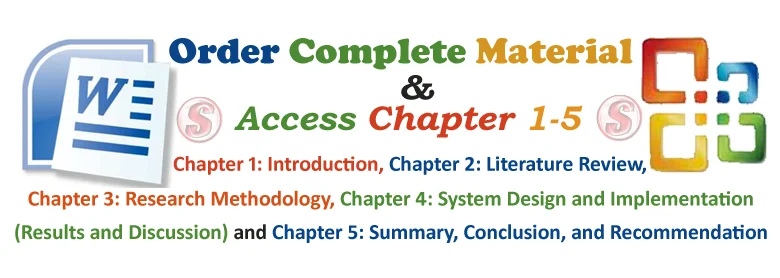1.1 Introduction
Malaria symptoms usually occur between seven and fifteen days after a mosquito inoculation. Signs and symptoms related to malaria infection are varied, but the majority of patients have fever. It is generally characterized by recurrent attacks with moderate to severe shaking chills, high-fever, profuse sweating during the fall of body temperature, general feeling of unease and discomfort (malaise). Other signs and symptoms are headache, nausea, vomiting and diarrhea. Malaria should be suspected in every febrile patient who lives or has traveled to an endemic area and in the differential diagnosis of patients who have fever of unknown origin, malaria should also be considered. Any patient with an untreated P. falciparum infection can rapidly progress to coma, renal failure, pulmonary edema, and death (MMWR, 2004).
As a prelude to other parts of this study, this chapter will discuss the background upon which this study was initiated, the statement of problems that led to this study, the Aim and Objectives of the study. Others are Significance of the study, Scope of work, Research hypothesis and questions, Limitations of the Study and Definition of technical terms.
1.2 Background of Study
Malaria still remains a significant public health problem especially in low and middle income countries. According to the World Health Organisation (WHO), malaria transmission in Nigeria is abysmally high with over 76% of the population reporting more than 1 case per 1,000 populations annually. There was a less than 50% decrease in projected incidence of malaria from 2000—2015. Nigeria and the Democratic Republic of Congo account for more than 35% of the global total of estimated malaria deaths.
Malaria is principally caused by protozoa (Plasmodium species) and is transmitted through the bite of an infected female Anopheles mosquito (Mwangangi et al., 2013). Within the tropics and sub-tropics, human malaria is seen to be the most wide spread vector-borne disease (Ahmad et al., 2011). Available statistics have documented that malaria is highly endemic in Nigeria with over 90% of the populace at risk of infection. It is the prime cause of 60% outpatient consultation for all age groups and at least half of the Nigerian populace are exposed to at least one bout of malaria attack every year (Idowu J., 2012).
An integrative approach has been recommended to mitigate the spread of malaria parasites. One of such strategy or approach is the Integrated Vector Management (IVM) through a combination of biological and chemical methods. It is aimed at improving ecological soundness and sustainability for the control of vector borne diseases, improve efficacy and cost effectiveness (Zacchaeus and Amadi, 2012). From a triad perspective which includes the agent, host and environment, researchers and scholars have encouraged the source reduction, elimination and eradication of mosquitoes breeding sites by concentrating on the environment. These tend to be essential because, the proliferation of mosquitoes continually perpetuate the transmission of malaria. So, it can be postulated that if the sources of mosquitoes breeding sites is eradicated or eliminated, malaria would be drastically reduced. This implies that good environmental sanitation practices could help mitigate malaria transmission, promote healthiness and improve quality of life of the populace.
In its modern concept, environment includes not only water, air and soil but also the social and economic conditions under which we live (Park, 2011). The key to man's health lies largely in his environment. In fact, much of man's ill-health can be traced to adverse environmental factors such as water, soil and air pollution, poor housing conditions, presence of animal reservoir and insect vectors of diseases which pose threats to man's health. Often, man is responsible for the pollution of his environment through urbanization, industrialization and other human activities.
According to the National Sanitation Foundation of USA, the word sanitation is defined as a way of life that is expressed in the clean home, farm, business, neighborhoods and community (Park, 2011). Also, World Health Organization (WHO) defines sanitation as the provision of facilities and services for the safe disposal of human urine and faeces (UNICEF AND WHO, 2012).
Environmental hazards are responsible for about a quarter of the total burden of disease worldwide and as much as 30% in regions such as sub-Saharan Africa. As many as 13 million deaths can be prevented every year by making our environments healthier. These facts and figures highlight the impact of environmental factors on public health. More than 2.4 billion people in the world currently lack access to adequate sanitation and are forced to dispose of their excreta in unimproved and unsanitary conditions. Those who suffer from this, lack most basic human needs and also tend to be victims of poverty, ill health and an overall poor quality of life (WHO, 2013).
In developing countries like Nigeria, the main diseases of the environment are diarrhoeal disease, lower respiratory infections, unintentional injuries, and malaria. In children under the age of five, one third of all disease is caused by the environmental factors such as unsafe water and air pollution (WHO, 2010). The poor state of food sanitation in the country has been shown to play a significant role in the etiology of food borne diseases. One of the most significant diseases that arise from poor sanitation is diarrhea. Deaths resulting from diarrhea are estimated to be between 1.6 and 2.5 million every year (WHO, 2012). National records show that every year, about six hundred thousand (600,000) episodes of diarrhoea occur in children under the age of five (Alabi, 2010).
Similarly, there have been increasing numbers of cases of cholera over the years. From January to December 2010, Nigeria reported 41,787 cases including 1,716 deaths from 222 Local Government Areas (LGAs) in 18 States of the country. The most affected states were Borno, Bauchi and Katsina. In addition to the disease burden, Nigeria loses about N455 billion annually which is equivalent to 1.3% of Gross Domestic Product (GDP), due to poor sanitation as reported by water and sanitation program of the World Bank (Vanguard 2013). Most of the affected are young children below the ages of five. Other diseases that are caused by poor sanitation include schistosomiasis, trachoma, soil transmitted helminthiases, and malaria (WHO, 2013).
One of the essential public health care elements is provision of safe drinking water and sanitation. However, deposition of faecal matter near homes, contamination of sources of drinking water (sometimes caused by poorly designed or maintained sewage system), dumping of refuse and sweeping into the gutters, defecating and disposing of faeces by the street corners and waterways and selling of food stuffs and cooked food by the road side are all unwholesome practices that pose potential risk to the development of diseases. Water quantity is as important as water quality. Washing of hands after defecation and before preparing food is of particular importance in reducing disease transmission, as has been demonstrated by Nigeria's recent control over Ebola Viral Disease. Poor housing also contributes to poor environment health and its consequent input in the health of the urban dwellers. Measures for the prevention of cholera mostly consist of providing clean water and proper sanitation to populations who do not yet have access to basic services. Health education and good food hygiene are equally important.
The environmental sanitation-related diseases exacer-bate poverty by diminishing productivity and household income. In addition, the national cost of lost productivity, reduced educational potential and huge curative health costs constitute a major drain on the local and national economy. Besides, a dirty environment with its attendant health consequences, prevailing in most of our cities, can discourage tourists/investors and undermine the economic benefit of tourism to the country. Consequently, wide-ranging actions are required to solve Environmental Sanitation problems in order to reduce and avert their adverse health, economic and developmental effects.
Therefore, in Nigeria where the research was carried out, the activities that was conducted is to assess the effectiveness of environmental sanitation in the control of malaria.
1.3 Statement of Problems
Investigation revealed that inadequate sanitation is a major cause of disease world-wide and improving sanitation is known to have a significant beneficial impact on health both in households and across communities. The word ‘sanitation' also refers to the maintenance of hygienic conditions through services such as garbage collection and waste-water disposal. In addition, environmental sanitation according to World Health Organization is the control of all those factors in man's physical environment which exercise or may exercise a deleterious effect on his physical development, health and survival.
It could also be seen as the principle and practice of effecting healthful and hygienic conditions in the environment to promote public health and welfare, improve quality of life and ensure a sustainable environment (Alabi, 2010). The essential components of environmental sanitation include: solid waste management; medical waste management; excreta and sewage management; food sanitation; sanitary inspection of premises; market and abattoir sanitation; adequate potable water supply; school sanitation; pest and vector control; management of urban drainage; control of reared and stray animals; disposal of the dead animals; weed and vegetation control; hygiene education and promotion.
1.4 Aim and Objectives of Study
The aim of the study is to assess the effectiveness of environmental sanitation in the control of malaria using Abeokuta metropolis as a case study. In achieving this aim, the following specific objectives were laid out as follows:
- To ascertain if inhabitants of Abeokuta metropolis know the implications of indiscriminate waste disposal in their environment.
- To find out the level of efficiency in the control and management of waste in Abeokuta metropolis.
- To know the rate of malaria infection among inhabitants of Abeokuta metropolis.
- To investigate if inhabitants of Abeokuta metropolis adopt an effective environmental sanitation.
- To examine the effect of environmental sanitation on the spread of malaria among inhabitants of Abeokuta metropolis.
1.5 Research Questions
The study came up with research questions so as to be able to ascertain the above stated objectives. The specific research questions for the study are stated below as follows:
- Do inhabitants of Abeokuta metropolis know the implications of indiscriminate waste disposal in their environment?
- Do inhabitants of Abeokuta metropolis adopt an effective environmental sanitation?
- What is the level of efficiency in the control and management of waste in Abeokuta metropolis?
- What is the rate of malaria infection among inhabitants of Abeokuta metropolis?
- What is the effect of environmental sanitation on the spread of malaria among inhabitants of Abeokuta metropolis?
1.6 Research Hypothesis
In order to pursue the objective of this study, the following generalized statements have been designed to guide and aids in obtaining the result for the experiment to be conducted. For this work, the null hypothesis will be represented with H0 while the alternative hypothesis will be represented with hypothesis H1.
Hypothesis One
- H0: The inhabitants of Abeokuta metropolis does not know the implications of indiscriminate waste disposal in their environment
- H1: The inhabitants of Abeokuta metropolis know the implications of indiscriminate waste disposal in their environment
Hypothesis Two
- H0: There is no significant effect of environmental sanitation on the spread of malaria among inhabitants of Abeokuta metropolis
- H1: There is a significant effect of environmental sanitation on the spread of malaria among inhabitants of Abeokuta metropolis
1.7 Significance of Study
Considering the significant of the environment on the control and prevention of malaria, this study was aimed at assessing environmental sanitation practices on malaria prevention and control bin Abeokuta metropolis. The findings in this study are also important to the government because it elucidates the need for government to provide an effective waste management and control scheme.
This study will enhance the existing body of literature by contemplating the areas of the literature that have not yet been examined or considered and incorporating these factors into the current study. The study will thus form the basis for further studies in the field.
1.8 Scope of Study
The study focuses on the assessment of the effectiveness of environmental sanitation in the control of malaria using Abeokuta metropolis as a case study.
1.9 Limitations of the Study
During the course of this study, many things militated against its completion, some of which are:
- Time Constraint: The time frame given to accomplish this project was very short due to school academic calendar and it was carried out under pressure which made the researcher not to implement some necessary features.
- Research material: availability of research material is a major setback to the scope of the study.
- Frequent power failure: This made the researcher append more money on fuel to ensure sustainable power.
- Financial Constraint: Insufficient fund tends to impede the efficiency of the researcher in sourcing for the relevant materials, literature or information and in the process of data collection (internet, questionnaire and interview).
1.10 Definition of Terms
Symptoms: Is the sign given when a particular thing want to happen
Vaccines: Are things you do to keep something away or to prevent a disease.
Diagnosis: The act or process of identifying or determining the nature and cause of a disease injury through evaluation, examination review of a patient laboratory data




